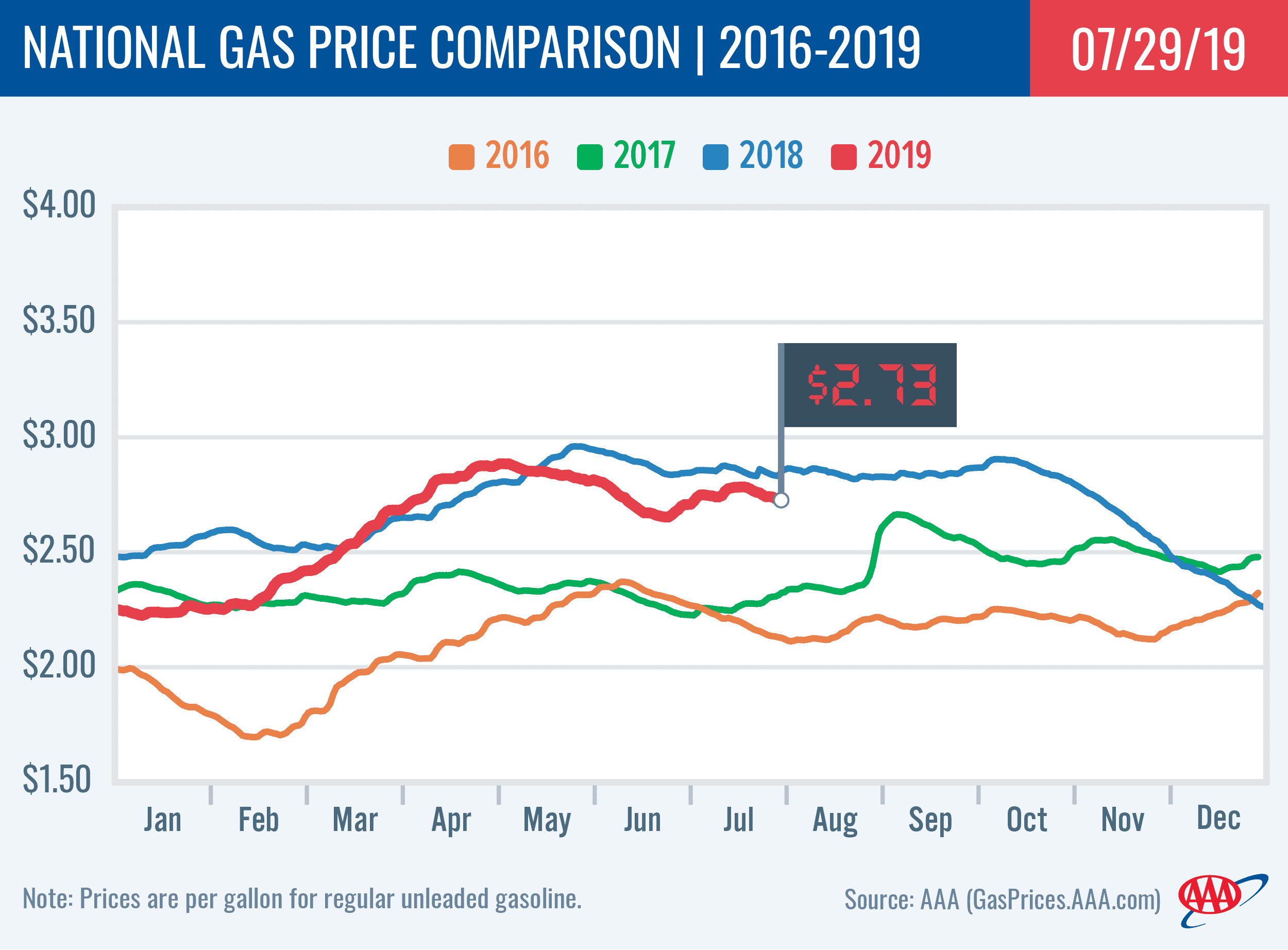PORTLAND, Ore., – Gas prices continue to move lower in almost every state. For the week, the national average for regular loses three cents to $2.73 a gallon. The Oregon average slips three cents to $3.15.
“Gas prices have been steadily declining this summer. That coupled with the fact that the national and Oregon averages are more than a dime lower than they were in July 2018 is encouraging summer road trips as evidenced by robust demand numbers since May,” says Marie Dodds, public affairs director for AAA Oregon/Idaho. “Pump prices are likely to keep ticking down going into August, barring a hurricane or escalating tensions in the Middle East.”
Oregon is one of 48 states and the District of Columbia where prices are lower now than a week ago. Florida (-9 cents) and Kentucky (-6 cents) have the largest weekly declines. Michigan (+4 cents) is the only state with a weekly increase. Prices are flat in Ohio. This week there are six states with an average above $3 a gallon, down from seven a week ago.
Oregon is one of 22 states with lower prices now than a month ago. The national average is one cent more and the Oregon average is eight cents less than a month ago. Alaska (-14 cents) has the largest month-over-month decline, while Illinois (+11 cents) has the largest monthly increase. Prices are flat in Oklahoma.
Oregon is one 47 states and the District of Columbia where drivers are paying less than a year ago. The national average is 13 cents less and the Oregon average is 14 cents less than a year ago. Delaware (-27 cents) has the largest year-over-year drop. California (+7 cents) has the biggest year-over-year increase.
The West Coast continues to have the highest pump prices in the nation with all of the region’s states except Arizona landing on the top 10 most expensive list.
California tops the list for the 19th consecutive week with Hawaii, Washington, Nevada, Oregon and Alaska rounding out the top six. Oregon is fifth most expensive for the second week in a row. Most state averages in the region have decreased on the week, with Alaska (-5 cents) seeing the largest decline.
The latest report from the U.S. Energy Information Administration (EIA) for the week ending July 19 shows that West Coast gasoline stocks sit at 32 million bbl, remaining unchanged from the previous week. The current level is almost 1.5 million bbl higher than last year at this time, which could help prices stabilize if there is any disruption in supply or gas demand increases in the region this week.
The cheapest gas in the nation can be found in Mississippi ($2.36) and Louisiana ($2.36). For the 24th week in a row, no states have an average below $2 a gallon.
Oil market dynamics
Crude prices mostly increased last week after EIA’s weekly report showed that total domestic crude inventories fell by 10.8 million bbl. With OPEC continuing to reduce crude production, tighter domestic crude supplies could cause prices to continue to increase if demand tightens. Unresolved tension in the Middle East also contributed to price increases last week. Iran has not released the U.K.-flagged oil tanker it captured in the Strait of Hormuz. In response, the British Royal Navy announced that it would escort U.K.-flagged vessels in the region to protect against future attacks. If tensions continue to mount this week, crude prices will likely continue their ascent.
At the close of Friday’s formal trading session on the NYMEX, WTI increased by 18 cents to settle at $56.20. At the close of Monday’s formal trading session on the NYMEX, WTI added 67 cents to $56.87. Today crude is trading around $57, compared to $56 a week ago. Crude prices are down about three percent in the last month and are about $12 per barrel less than a year ago.
Drivers can find current gas prices along their route with the free AAA Mobile app for iPhone, iPad and Android. The app can also be used to map a route, find discounts, book a hotel and access AAA roadside assistance. Learn more at AAA.com/mobile.
Diesel
For the week, the national average slips a penny to $2.99 a gallon. Oregon’s average also ticks down a penny to $3.18. A year ago the national average for diesel was $3.15 and the Oregon average was $3.40.
Find current fuel prices at GasPrices.AAA.com.
AAA news releases, high resolution images, broadcast-quality video, fact sheets and podcasts are available on the AAA NewsRoom at NewsRoom.AAA.com.
Find local news releases at https://www.oregon.aaa.com/category/news-releases/
Fuel prices are updated daily at AAA’s Daily Fuel Gauge at AAA Gas Prices. For more info go www.AAA.com. AAA Oregon/Idaho provides more than 810,000 members with travel, insurance, financial and automotive-related services, and is an affiliate of AAA National, serving more than 59 million motorists in North America.



